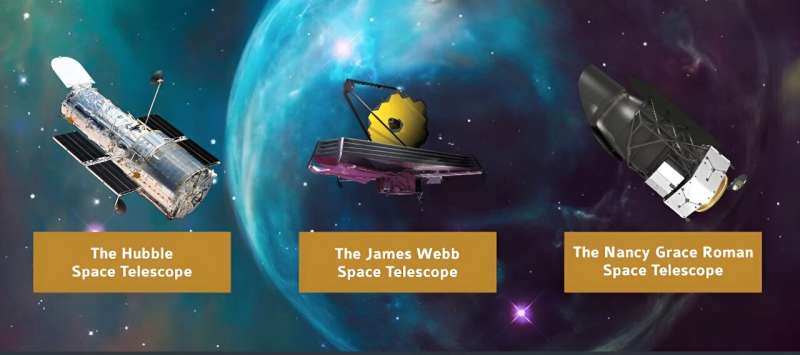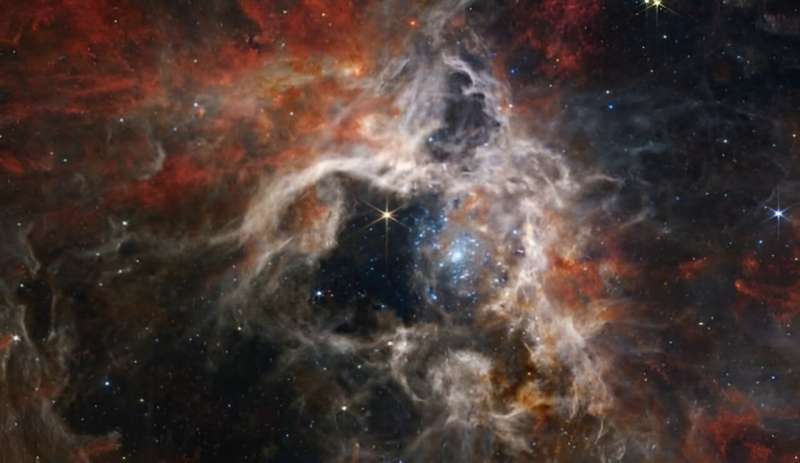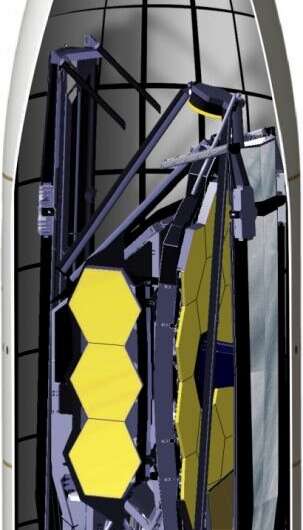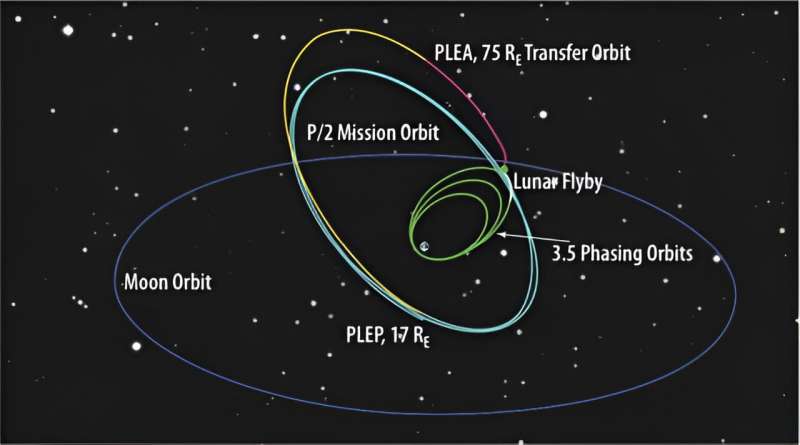This article has been reviewed according to Science X's editorial process and policies. Editors have highlighted the following attributes while ensuring the content's credibility:
fact-checked
preprint
trusted source
proofread
How can we bring down the costs of large space telescopes?

We're all basking in the success of the James Webb Space Telescope. It's fulfilling its promise as our most powerful telescope, making all kinds of discoveries that we've been anticipating and hoping for. But the JWST's story is one of broken budgets, repeated requests for more time and money, and near-cancellations.
Can we make space telescopes less expensive?
The JWST is barely a year into its mission and we're already anticipating the next space telescopes. NASA is already planning and developing the Nancy Grace Roman Space Telescope (formerly WFIRST) and the Habitable Worlds Observatory (formerly LUVOIR) for launch in 2027 and the late 2030s, respectively.
These space telescopes will likely be extremely expensive. However, a team of researchers thinks there are ways to bring the cost of space telescopes down. They've written a paper presenting their thoughts titled "Approaches to lowering the cost of large space telescopes." The lead author is Ewan Douglas, an Assistant Professor of Astronomy at the University of Arizona, Steward Observatory. They presented their paper at the SPIE Optics + Photonics 2023 conference in August. It is available on the arXiv preprint server.
There's no doubting the scientific rationale for large space telescopes. They deliver results impossible to get in any other way. There's also no doubting their expense and their drain on NASA's budget. They can never be cheaper than ground-based telescopes, but ground-based telescopes simply can't perform the way space telescopes can.

Nobody wants to give up the scientific progress stemming from powerful space telescopes. But it's hard to counter the criticisms that they're getting too expensive. Douglas and his co-authors have some ideas on how we can continue to generate new discoveries with space telescopes while making the cost more palatable.
Their paper focuses on a hypothetical 6.5 m mirror optical light that operates in space at room temperature. 6.5 meters is the same size as the JWST's mirror. They show how some technologies are becoming cheaper, how some technology that was cutting edge is now nearly off-the-shelf, and how spacecraft like SpaceX's Starship means we can launch telescopes with larger primary mirrors without building complex, expensive mirrors like the James Webb's.
Ground-based telescopes saw a pronounced drop in costs after 1980, and the researchers say the same thing can happen with space telescopes. "Thus, research and new economies of scale enabled by prior research into optics, commercial electronics, and the SpaceX StarShip could have a similar impact on space astronomy and drive the cost of multiple large observatories down into the regime between the NewSpace projections and ground-based observatories," they write. (See NewSpace at this link.)
Launching capabilities play a critical role in costs. Not just the expense of a rocket launch itself, but by restricting the size of a telescope's primary mirror. The JWST's primary mirror was folded to fit into the Ariane 5's payload fairing. That meant that it needed a complicated, expensive, and risky mirror that unfolded while it traveled to its position. Launch restrictions were a significant financial burden on the mission.
But SpaceX's Starship should be able to load a 6.5-meter mirror in one piece. "The fairing of the SpaceX Starship has the potential for a 6.5 m JWST-class telescope to be directly launched with a monolithic mirror, removing the cost and complexity of segmented mirror designs," they write. If that can be reliable, then the 6.5 mirror design could be used in multiple telescopes. Most of the cost of building a 6.5-meter mirror is in the primary optic material, and honeycomb borosilicate mirrors are relatively inexpensive. So instead of custom designing and building each mirror, we could reach a sort of economy of scale.

The authors say there is a standard 6.5-meter mirror that almost fits the bill, the "… field-proven Richard F. Caris Mirror Lab 6.5 m light-weighted borosilicate honeycomb mirror without modification." Honeycombs have the same advantages as other solid counterparts but are lighter and can be significantly larger. Borosilicate glass is used because it resists thermal expansion, is moldable at low temperatures, and is relatively inexpensive. For comparison, the JWST's mirror is made of beryllium and coated with a thin layer of gold.
A borosilicate mirror in a space telescope would require adaptive optics. But this is another area where ground-based telescopes have been a proving ground. The technology of adaptive optics and wavefront control is getting better and better and can be adapted to a 6.5-meter space telescope. Newer, faster CMOS sensors also help eliminate image distortion because they need less time to capture images, and they're also getting larger and cheaper.
Unlike the surface of the Earth, space is a radiation free-for-all. Electronics need to be able to work in this environment, and so does software. "Historically, purpose-built flight computers ran assembly language and required costly and niche software development skills," the authors write. But that's changing. Commercial off-the-shelf (COTS) electronics are now being implemented in space missions, and so are common operating systems. For example, the Mars Ingenuity Helicopter runs on Linux, and so do some wavefront control systems on CubeSats.
The JWST sits at the sun-Earth L2 to do its business. It needs to be in a thermally stable environment for its powerful IR sensors to be effective. But it costs more to get the telescope there, and it requires more power to transmit its data. Douglas and his colleagues say there's another option, at least for optical telescopes, one used by TESS.
TESS is in a 13.7-day period in High Earth Orbit (HEO.) It used lunar gravity assist to get there, which helped lower launch costs. "The TESS HEO orbit provides a large continuous sky coverage in a thermally stable low radiation environment for relatively low Delta V, lowering the propulsion needs for space observatories and increasing potential data downlink relative to L2 orbits for the same transmitter power." TESS's orbit should be stable for decades or longer without the need for propulsion.

Some advancements in telescope design lower the costs while not directly involving technology. Significant developments in design processes have streamlined procedures and reduced costs by saving time. "Over the past several decades, advances in development processes for software with version control, project management, test-based design, and continuous integration and deployment have increased the development pace of increasingly complex software," the paper states.
Document management might not ignite much enthusiasm for most of us, but it's an example of a critical piece of the telescope design process that can benefit from improvement and lower costs. It takes thousands of people with specialized skills decades to design, build, and launch a space telescope. Streamlined communication methods can help lower costs. The authors mention examples like machine-readable documents, and using the open-source JSON file format and its schemas to reduce errors. Even change tracking and automated distribution of documents can be improved to help lower costs. "These tools make an iterative, prototype-heavy design process more feasible since lessons learned are captured naturally," they explain.
Some of the changes they've outlined have already been used in SmallSats, CubeSats, and in some cases, even larger projects like the Nancy Grace Roman Space Telescope. In fact, SmallSats provide an encouraging look at how we can lower costs without sacrificing science.
The paper dives into more technical detail, even though the authors say this is a preliminary look at the issue and that future papers will dig even deeper. But they've shown that there's a way forward where we can continue to advance astronomy and astrophysics without creating skyrocketing budgets.
"Future work will provide details of how such an observatory might come about, additional risk mitigation strategies, detailed instrument designs, and present the environmental requirements necessary for a honey-comb borosilicate mirror to survive launch," they conclude.
More information: Ewan S Douglas et al, Approaches to lowering the cost of large space telescopes, arXiv (2023). DOI: 10.48550/arxiv.2309.04934
Journal information: arXiv
Provided by Universe Today





















